Lantronix EDS8PS, EDS32PR, EDS16PS, EDS8PR, EDS4100 User Manual
...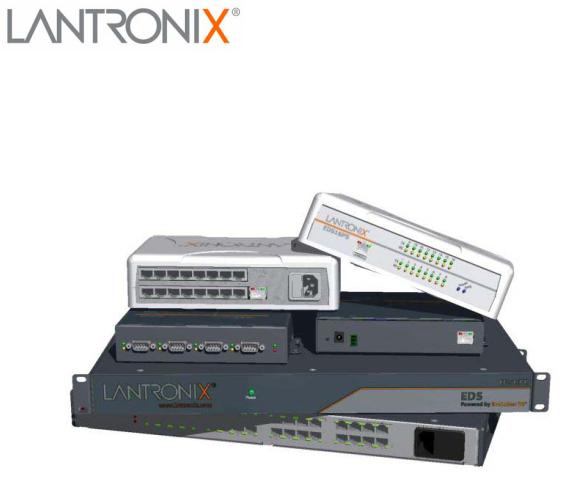
EDS Device Servers/Terminal Servers
User Guide
EDS4100 EDS8PS EDS16PS EDS8PR EDS16PR EDS32PR
Part Number 900-433
Revision I April 2011

Copyright & Trademark
© 2011 Lantronix. All rights reserved. No part of the contents of this book may be transmitted or reproduced in any form or by any means without the written permission of Lantronix. Printed in the United States of America.
Ethernet is a trademark of XEROX Corporation. UNIX is a registered trademark of The Open Group. Windows is a trademark of Microsoft Corporation.
Warranty
For details on the Lantronix warranty replacement policy, please go to our web site at www.lantronix.com/support/warranty.
Contacts
Lantronix Corporate Headquarters
167 Technology Drive
Irvine, CA 92618, USA
Phone:949-453-3990 Fax:949-450-7249
Technical Support
Online: www.lantronix.com/support
Sales Offices
For a current list of our domestic and international sales offices, go to the Lantronix web site at www.lantronix.com/about/contact.
Disclaimer
Note: This product has been designed to comply with the limits for a Class B digital device pursuant to Part 15 of FCC and EN55022:1998 Rules when properly enclosed and grounded. These limits are designed to provide reasonable protection against radio interference in a residential installation. This equipment generates, uses, and can radiate radio frequency energy, and if not installed and used in accordance with this guide, may cause interference to radio communications. See “Appendix C - Compliance” on
page 155 for additional information.
The information in this guide may change without notice. The manufacturer assumes no responsibility for any errors that may appear in this guide.For the latest revision of this product document, please check our online documentation at www.lantronix.com/support/documentation.
EDS User Guide |
2 |

Revision History
Date |
Rev. |
Comments |
March 2006 |
A |
Initial Document |
|
|
|
October 2006 |
B |
EDS16PR and EDS32PR products added. |
|
|
|
December 2006 |
D |
German and English TUV certification added. |
|
|
|
January 2007 |
E |
EDS8PR product added. |
|
|
|
November 2007 |
F |
Added LPD, Terminal Host, RSS, and RT pages; updated XML and |
|
|
other pages. |
|
|
|
November 2008 |
G |
EDS8PS and EDS16PS products added. |
|
|
|
May 2009 |
H |
Updated for EDS8/16/32PR and EDS4100 v4.1.0.2. |
|
|
|
April 2011 |
I |
Updated for firmware version 5.2.0.0R24. Added support for Modbus |
|
|
protocol for EDS4100, configurable MTU, and additional VIP tunnel |
|
|
connect protocols; as well as impr ovements to SNMP, logging, and SSL. |
|
|
|
EDS User Guide |
3 |

Table of Contents
List of Figures ____________________________________________________________10 List of Tables _____________________________________________________________12
1: About This Guide |
14 |
Chapter and Appendix Summaries ____________________________________________14 Additional Documentation ___________________________________________________15
2: Introduction |
16 |
EDS8PS and EDS16PS Overview ____________________________________________17 Features __________________________________________________________17 EDS4100 Overview ________________________________________________________18 Features _________________________________________________________18 EDS8PR, EDS16PR, and EDS32PR Overview __________________________________19 Features __________________________________________________________19 Applications ______________________________________________________________20 Protocol Support _________________________________________________________20 Evolution OS™ ___________________________________________________________20 Additional Features ________________________________________________________21 Modem Emulation ______________________________________________________21 Web-Based Configuration and Troubleshooting _______________________________21 Command-Line Interface (CLI) ____________________________________________21 VIP Access ___________________________________________________________21 SNMP Management ____________________________________________________21 XML-Based Architecture and Device Control _________________________________21 Really Simple Syndication (RSS) __________________________________________21 Enterprise-Grade Security _______________________________________________21 Terminal Server/Device Management ______________________________________22 Troubleshooting Capabilities _____________________________________________22 Configuration Methods _____________________________________________________22 Addresses and Port Numbers ________________________________________________23 Hardware Address _____________________________________________________23 IP Address ___________________________________________________________23 Port Numbers _________________________________________________________23
Product Information Label ___________________________________________________24
3: Installation of EDS8PS and EDS16PS |
25 |
Package Contents _________________________________________________________25 User-Supplied Items _______________________________________________________25 Identifying Hardware Components ____________________________________________26 Serial Ports ___________________________________________________________26
EDS User Guide |
4 |

Console Port __________________________________________________________26 Ethernet Port _________________________________________________________27 LEDs ________________________________________________________________27 Reset Button __________________________________________________________27 Reboot the device: __________________________________________________27 Restore factory defaults: _____________________________________________28 Installing the EDS8/16PS ___________________________________________________28 Finding a Suitable Location ______________________________________________28 Connecting the EDS8/16PS ______________________________________________28 Connect the EDS8/16PS to one or more serial devices. _____________________28
4: Installation of EDS4100 |
30 |
Package Contents _________________________________________________________30 User-Supplied Items _______________________________________________________30 Identifying Hardware Components ____________________________________________30 Serial Ports ___________________________________________________________31 Ethernet Port _________________________________________________________32 Terminal Block Connector _______________________________________________33 LEDs ________________________________________________________________33 Reset Button __________________________________________________________33 Physically Installing the EDS4100 _____________________________________________34 Finding a Suitable Location ______________________________________________34 Connecting the EDS4100 ________________________________________________34 Connect the EDS4100 to one or more serial devices. _______________________34
5: Installation of EDS8PR, EDS16PR and EDS32PR |
36 |
Package Contents _________________________________________________________36 User-Supplied Items _______________________________________________________36 Identifying Hardware Components ____________________________________________37 Serial Ports ___________________________________________________________37 Console Port __________________________________________________________37 Ethernet Port _________________________________________________________38 LEDs ________________________________________________________________38 Reset Button __________________________________________________________39 Installing the EDS8/16/32PR _________________________________________________39 Finding a Suitable Location ______________________________________________39 Connecting the EDS8/16/32PR ___________________________________________39
6: Using DeviceInstaller |
41 |
Accessing EDS Using DeviceInstaller __________________________________________41 Device Details Summary ____________________________________________________41
EDS User Guide |
5 |

7: Configuration Using Web Manager |
43 |
Accessing Web Manager ___________________________________________________43 Device Status Page ____________________________________________________44 Web Manager Page Components _____________________________________________45 Navigating the Web Manager ________________________________________________46
8: Network Settings |
48 |
Network 1 (eth0) Interface Status _____________________________________________48 Network 1 (eth0) Interface Configuration _______________________________________49 Network 1 Ethernet Link ____________________________________________________51
9: Line and Tunnel Settings |
52 |
Line Settings _____________________________________________________________52 Line Statistics _________________________________________________________52 Line Configuration _____________________________________________________53 Line Command Mode ___________________________________________________55 Tunnel Settings __________________________________________________________ 56 Tunnel – Statistics _____________________________________________________57 Tunnel – Serial Settings _________________________________________________59 Tunnel – Packing Mode _________________________________________________60 Tunnel – Accept Mode __________________________________________________63 Tunnel – Connect Mode _________________________________________________66 Connecting Multiple Hosts ____________________________________________70 Host List Promotion _________________________________________________70 Tunnel – Disconnect Mode _______________________________________________71 Tunnel – Modem Emulation ______________________________________________72
10: Terminal and Host Settings |
75 |
Terminal Settings _________________________________________________________75 Line Terminal Configuration ______________________________________________75 Network Terminal Configuration ___________________________________________77 Host Configuration ________________________________________________________78
11: Service Settings |
79 |
DNS Settings _____________________________________________________________79 SNMP Settings ___________________________________________________________80 FTP Settings ____________________________________________________________81 TFTP Settings ___________________________________________________________83 Syslog Settings ___________________________________________________________84 HTTP Settings ____________________________________________________________85
HTTP Statistics ________________________________________________________85 HTTP Configuration ____________________________________________________86
EDS User Guide |
6 |

HTTP Authentication ___________________________________________________88 RSS Settings _____________________________________________________________89 LPD Settings _____________________________________________________________90 LPD Statistics _________________________________________________________90 LPD Configuration _____________________________________________________91
12: Security Settings |
93 |
SSH Settings _____________________________________________________________93 SSH Server Host Keys _________________________________________________94 SSH Server Authorized Users ____________________________________________98 SSH Client Known Hosts _______________________________________________100 SSH Client Users _____________________________________________________101
SSL Settings ____________________________________________________________103 SSL Cipher Suites ____________________________________________________103 SSL Certificates ______________________________________________________104 SSL RSA or DSA _____________________________________________________104 SSL Certificates and Private Keys ________________________________________104 SSL Utilities _________________________________________________________105
OpenSSL ___ _____________________________________________________105 Steel Belted RADIUS _______________________________________________105 Free RADIUS _____________________________________________________105 SSL Configuration ____________________________________________________106
13: Modbus |
109 |
Serial Transmission Mode __________________________________________________109 Modbus Statistics ________________________________________________________110 Modbus Configuration _____________________________________________________111
14: Maintenance and Diagnostics Settings |
112 |
Filesystem Settings _______________________________________________________112 Filesystem Statistics ___________________________________________________112 Filesystem Browser ___________________________________________________113 Protocol Stack Settings ____________________________________________________115 TCP Settings ________________________________________________________115 IP Settings __________________________________________________________116 ICMP Settings ________________________________________________________116 ARP Settings ________________________________________________________118 SMTP Settings _______________________________________________________119
IP Address Filter _________________________________________________________120 Query Port _____________________________________________________________121 Diagnostics __ ___________________________________________________________122 Hardware ___ ________________________________________________________122
EDS User Guide |
7 |

MIB-II Statistics _______________________________________________________123 IP Sockets __________________________________________________________124 Ping __ _____________________________________________________________124 Traceroute __ ________________________________________________________126 Log ___ _____________________________________________________________127 Memory _____________________________________________________________129 Buffer Pools _________________________________________________________129 Processes ___________________________________________________________130
Real Time Clock _________________________________________________________132 System Settings _________________________________________________________132
15: Advanced Settings |
134 |
Email Settings ___________________________________________________________134 Email Statistics _______________________________________________________134 Email Configuration ___________________________________________________135 Command Line Interface Settings ____________________________________________137 CLI Statistics _________________________________________________________137 CLI Configuration _____________________________________________________137 XML Settings ____________________________________________________________139 XML: Export Configuration ______________________________________________140 XML: Export Status ____________________________________________________141 XML: Import Configuration ______________________________________________142 Import Configuration from External File _________________________________142 Import Configuration from the Filesystem _______________________________143 Import Line(s) from Single Line Settings on the Filesystem __________________145
16: VIP Settings |
147 |
Obtaining a Bootstrap File __________________________________________________147 Importing the Bootstrap File ________________________________________________147 Enabling VIP ____________________________________________________________148 Configuring Tunnels to Use VIP _____________________________________________148 Virtual IP (VIP) Statistics ___________________________________________________148 Virtual IP (VIP) Counters ___________________________________________________149 Virtual IP (VIP) Configuration _______________________________________________149
17: Branding the EDS |
150 |
Web Manager Customization |
_______________________________________________150 |
Short and Long Name Customization _________________________________________150
18: Updating Firmware |
151 |
Obtaining Firmware _______________________________________________________151 Loading New Firmware ____________________________________________________151
EDS User Guide |
8 |

Appendix A - Technical Support |
152 |
Technical Support US ______________________________________________152 Technical Support Europe, Middle East, Africa ___________________________152
Appendix B - Binary to Hexadecimal Conversions |
153 |
Converting Binary to Hexadecimal ________________________________________153 Conversion Table __________________________________________________153 Scientific Calculator ________________________________________________154
Appendix C - Compliance |
155 |
Lithium Battery Notice _____________________________________________________156 Installationsanweisungen __ ________________________________________________156 Rackmontage ___ _____________________________________________________156 Energiezufuhr ___ _____________________________________________________157 Erdung __ ___________________________________________________________157 Installation Instructions ____________________________________________________157 Rack Mounting _______________________________________________________157 Input Supply _________________________________________________________157 Grounding ___________________________________________________________157
Appendix D - Lantronix Cables and Adapters |
158 |
Index |
159 |
EDS User Guide |
9 |

List of Figures
Figure 2-1 EDS8PS Device Server___________________________________________________17 Figure 2-2 EDS4100 4 Port Device Server _____________________________________________18 Figure 2-3 EDS16PR Device Server__________________________________________________19 Figure 2-4 Sample Hardware Address ________________________________________________23 Figure 2-5 Product Label___________________________________________________________24 Figure 3-1 Front View of the EDS8PS ________________________________________________26 Figure 3-2 Back View of the EDS8PS_________________________________________________26 Figure 3-3 RJ45 Serial Port_________________________________________________________27 Figure 3-5 Example of EDS8/16PS Connections ________________________________________29 Figure 4-1 Front View of the EDS4100 _______________________________________________31 Figure 4-2 Back View of the EDS4100 ________________________________________________31 Figure 4-3 RS-232 Serial Port Pins (Serial Ports 1, 2, 3, 4) ________________________________32 Figure 4-4 RS-422/RS-485 Serial Port Pins ____________________________________________32 Figure 4-5 Terminal Block Connector Pin Assignments ___________________________________33 Figure 4-7 Example of EDS4100 Connections __________________________________________35 Figure 5-1 Front View of the EDS16PR _______________________________________________37 Figure 5-2 Back View of the EDS16PR _______________________________________________37 Figure 5-3 RJ45 Serial Port_________________________________________________________38 Figure 5-5 Example of EDS16PR Connections _________________________________________40 Figure 7-1 Web Manager Home Page ________________________________________________44 Figure 7-2 Components of the Web Manager Page ______________________________________45 Figure 8-1 Network 1 (eth0) Interface Status ___________________________________________48 Figure 8-2 Network 1 (eth0) Interface Configuration______________________________________49 Figure 8-4 Network 1 Ethernet Link __________________________________________________51 Figure 9-1 Line 1 Statistics _________________________________________________________52 Figure 9-2 Line 1 Configuration______________________________________________________53 Figure 9-4 Line 1 Command Mode ___________________________________________________55 Figure 9-6 Tunnel 1 Statistics _______________________________________________________58 Figure 9-7 Tunnel 1 Serial Settings___________________________________________________59 Figure 9-9 Tunnel 1 Packing Mode (Mode = Disable) ____________________________________60 Figure 9-10 Tunnel 1 Packing Mode (Mode = Timeout) ___________________________________61 Figure 9-11 Tunnel 1 Packing Mode (Mode = Send Character) _____________________________61 Figure 9-13 Tunnel 1 Accept Mode___________________________________________________64 Figure 9-15 Tunnel 1 Connect Mode _________________________________________________67 Figure 9-17 Host 1, Host 2, Host 3 Exchanged__________________________________________70 Figure 9-18 Tunnel 1 Disconnect Mode _______________________________________________71 Figure 9-21 Tunnel 1 Modem Emulation_______________________________________________74 Figure 10-1 Terminal on Line Configuration____________________________________________75 Figure 10-3 Terminal on Network Configuration _________________________________________77 Figure 10-5 Host Configuration______________________________________________________78 Figure 11-1 DNS Settings __________________________________________________________79 Figure 11-2 SNMP Configuration ____________________________________________________80 Figure 11-4 FTP Configuration ______________________________________________________82 Figure 11-6 TFTP Configuration _____________________________________________________83 Figure 11-8 Syslog _______________________________________________________________84 Figure 11-10 HTTP Statistics _______________________________________________________85 Figure 11-11 HTTP Configuration____________________________________________________86 Figure 11-13 HTTP Authentication ___________________________________________________88 Figure 11-15 RSS ________________________________________________________________89 Figure 11-17 LPD Statistics ________________________________________________________90
EDS User Guide |
10 |

Figure 11-18 LPD Configuration _____________________________________________________91 Figure 12-1 SSH Server: Host Keys (Upload Keys) ______________________________________94 Figure 12-3 SSH Server: Host Keys (Upload Keys) ______________________________________96 Figure 12-5 SSH Server: Host Keys (Create New Keys) __________________________________97 Figure 12-7 SSH Server: Authorized Users ____________________________________________99 Figure 12-9 SSH Client: Known Hosts _______________________________________________100 Figure 12-11 SSH Client: Users ____________________________________________________101 Figure 12-14 SSL _______________________________________________________________106 Figure 13-3 Modbus Statistics______________________________________________________110 Figure 13-4 Modbus Configuration __________________________________________________111 Figure 14-1 Filesystem Statistics ___________________________________________________112 Figure 14-2 Filesystem Browser ____________________________________________________113 Figure 14-4 TCP Protocol _________________________________________________________115 Figure 14-6 IP Protocol __________________________________________________________116 Figure 14-8 ICMP Protocol ________________________________________________________117 Figure 14-10 ARP Protocol Page ___________________________________________________118 Figure 14-12 SMTP______________________________________________________________119 Figure 14-14 IP Address Filter Configuration __________________________________________120 Figure 14-16 Query Port Configuration_______________________________________________121 Figure 14-17 Diagnostics: Hardware_________________________________________________122 Figure 14-18 MIB-II Network Statistics _______________________________________________123 Figure 14-20 IP Sockets __________________________________________________________124 Figure 14-21 Diagnostics: Ping_____________________________________________________124 Figure 14-23 Diagnostics: Traceroute________________________________________________126 Figure 14-25 Diagnostics: Log _____________________________________________________127 Figure 14-26 Diagnostics: Log (Filesystem) ___________________________________________127 Figure 14-27 Diagnostics: Log (Line 1)_______________________________________________128 Figure 14-28 Diagnostics: Memory __________________________________________________129 Figure 14-29 Diagnostics: Buffer Pools_______________________________________________130 Figure 14-30 Diagnostics: Processes ________________________________________________131 Figure 14-31 Real Time Clock Page_________________________________________________132 Figure 14-33 System_____________________________________________________________133 Figure 15-1 Email Statistics _______________________________________________________134 Figure 15-2 Email Configuration ____________________________________________________135 Figure 15-4 CLI Statistics _________________________________________________________137 Figure 15-5 CLI Configuration______________________________________________________138 Figure 15-7 XML: Export Configuration_______________________________________________140 Figure 15-9 XML: Export Status ____________________________________________________141 Figure 15-11 XML: Import Configuration______________________________________________142 Figure 15-12 XML: Import Configuration from External File _______________________________142 Figure 15-13 XML: Import from Filesystem ___________________________________________143 Figure 15-14 XML: Import Configuration from Filesystem ________________________________144 Figure 15-15 XML: Import Line(s) from Single Line Settings on the Filesystem ________________145 Figure 16-1 VIP Status ___________________________________________________________148 Figure 16-2 VIP Counters _________________________________________________________149 Figure 16-4 VIP Configuration Page _________________________________________________149 Figure 18-1 Update Firmware ______________________________________________________151
EDS User Guide |
11 |

List of Tables
Table 3-4 Front Panel LEDs ________________________________________________________27 Table 4-6 Back Panel LEDs ________________________________________________________33 Table 5-4 Back Panel LEDs ________________________________________________________39 Table 6-1 Device Details Summary___________________________________________________41 Table 7-3 Summary of Web Manager Pages ___________________________________________46 Table 8-3 Network Interface Configuration _____________________________________________49 Table 8-5 Network 1 Ethernet Link ___________________________________________________51 Table 9-3 Line Configuration________________________________________________________54 Table 9-5 Line Command Mode _____________________________________________________55 Table 9-8 Tunnel - Serial Settings____________________________________________________59 Table 9-12 Tunnel Packing Mode ____________________________________________________62 Table 9-14 Tunnel Accept Mode_____________________________________________________64 Table 9-16 Tunnel Connect Mode____________________________________________________68 Table 9-19 Tunnel Disconnect Mode _________________________________________________71 Table 9-20 Modem Emulation Commands and Descriptions _______________________________72 Table 9-22 Tunnel Modem Emulation_________________________________________________74 Table 10-2 Terminal on Line 1 Configuration ___________________________________________76 Table 10-4 Terminal on Network Configuration _________________________________________77 Table 10-6 Host Configuration ______________________________________________________78 Table 11-3 SNMP ________________________________________________________________81 Table 11-5 FTP Settings ___________________________________________________________82 Table 11-7 TFTP Server ___________________________________________________________83 Table 11-9 Syslog ________________________________________________________________84 Table 11-12 HTTP Configuration ____________________________________________________86 Table 11-14 HTTP Authentication____________________________________________________88 Table 11-16 RSS_________________________________________________________________90 Table 11-19 LPD Configuration______________________________________________________91 Table 12-2 SSH Server Host Keys Settings - Upload Keys Method __________________________95 Table 12-4 SSH Server Host Keys Settings - Upload Keys Method __________________________96 Table 12-6 SSH Server Host Keys Settings - Create New Keys Method ______________________97 Table 12-8 SSH Server Authorized User Settings _______________________________________99 Table 12-10 SSH Client Known Hosts _______________________________________________100 Table 12-12 SSH Client Users _____________________________________________________102 Table 12-13 Supported Cipher Suites________________________________________________103 Table 12-15 SSL ________________________________________________________________107 Table 13-1 6 Byte Header of Modbus Application Protocol _______________________________109 Table 13-2 Modbus Transmission Modes_____________________________________________109 Table 13-5 Modbus Configuration___________________________________________________111 Table 14-3 Filesystem Browser_____________________________________________________114 Table 14-5 TCP Protocol Settings___________________________________________________115 Table 14-7 IP Protocol Settings ____________________________________________________116 Table 14-9 ICMP Settings_________________________________________________________117 Table 14-11 ARP Settings_________________________________________________________118 Table 14-13 SMTP Settings _______________________________________________________119 Table 14-15 IP Address Filter Settings _______________________________________________120 Table 14-19 Requests for Comments (RFCs)__________________________________________123 Table 14-22 Diagnostics: Ping _____________________________________________________125 Table 14-24 Diagnostics: Traceroute ________________________________________________126 Table 14-32 Real Time Clock Settings _______________________________________________132 Table 14-34 System _____________________________________________________________133
EDS User Guide |
12 |

Table 15-3 Email Configuration_____________________________________________________135 Table 15-6 CLI Configuration ______________________________________________________138 Table 15-8 XML Export Configuration________________________________________________140 Table 15-10 XML Export Status ____________________________________________________141 Table 15-16 XML: Import Line(s) from Single Line Settings _______________________________146 Table 16-3 VIP Counters__________________________________________________________149 Table 20-1 Binary to Hexadecimal Conversion Table____________________________________153
EDS User Guide |
13 |

1:About This Guide
This guide provides the information needed to configure, use, and update the EDS™ Device Server. It is intended for software developers and system integrators who are installing the EDS in their designs.
Chapter and Appendix Summaries
A summary of each chapter is provided below.
Chapter |
Description |
Chapter 2: Introduction |
Main features of the product and the protocols it supports. |
|
Includes technical specifications. |
Chapter 3: Installation of EDS8PS and EDS16PS |
Instructions for installing the EDS8PS and the EDS16PS |
|
device servers. |
Chapter 4: Installation of EDS4100 |
Instructions for installing the EDS4100 device server. |
|
|
Chapter 5: Installation of EDS8PR, EDS16PR and |
Instructions for installing the EDS8PR, the EDS16PR, and |
EDS32PR |
the EDS16PR device server. |
Chapter 6: Using DeviceInstaller |
Instructions for viewing the current configuration using |
|
DeviceInstaller. |
Chapter 7: Configuration Using Web Manager |
Instructions for accessing Web Manager and using it to |
|
configure settings for the device. |
Chapter 8: Network Settings |
Instructions for using the web interface to configure |
|
Ethernet settings. |
Chapter 9: Line and Tunnel Settings |
Instructions for using the web interface to configure line and |
|
tunnel settings. |
Chapter 10: Terminal and Host Settings |
Instructions for using the web interface to configure terminal |
|
and host settings. |
Chapter 11: Service Settings |
Instructions for using the web interface to configure settings |
|
for DNS, SNMP, FTP, and other services. |
Chapter 12: Security Settings |
Instructions for using the web interface to configure SSH |
|
and SSL security settings. |
Chapter 13: Modbus |
Instructions for using the web interface to configure |
|
Modbus. |
|
Note: Modbus is only available on the EDS4100 and |
|
is not supported on the EDS8PR, EDS16PR, |
|
EDS32PR, EDS8PS and EDS16PS. |
Chapter 14: Maintenance and Diagnostics Settings |
Instructions for using the web interface to maintain the |
|
device, view statistics, files, and logs, and diagnose |
|
problems. |
Chapter 15: Advanced Settings |
Instructions for using the web interface to configure email, |
|
CLI, and XML settings. |
Chapter 16: VIP Settings |
Information about Virtual IP (VIP) features available on the |
|
device and instructions for using the web interface to |
|
configure the VIP settings. |
Chapter 17: Branding the EDS |
Instructions for customizing the device. |
|
|
EDS User Guide |
14 |

|
1: About This Guide |
|
|
Chapter 18: Updating Firmware |
Instructions for obtaining the latest firmware and updating |
|
the device. |
Appendix A - Technical Support |
Instructions for contacting Lantronix Technical Support. |
Appendix B - Binary to Hexadecimal Conversions |
Instructions for converting binary values to hexadecimals. |
Appendix C - Compliance |
Lantronix compliance information. |
Appendix D - Lantronix Cables and Adapters |
Lantronix cables and adapters for use with the EDS devices |
|
are listed here according to part number and application. |
|
|
Additional Documentation
Visit the Lantronix web site at www.lantronix.com/support/documentation for the latest documentation and the following additional documentation.
Document |
Description |
EDS4100 Quick Start, |
Information about the EDS hardware installation and initial |
EDS8/16PS Quick Start, or |
configuration of your EDS device. |
EDS8/16/32PR Quick Start |
|
EDS Command Reference |
Instructions for accessing Command Mode (the command line |
|
interface) using a Telnet connection or through the serial port. |
|
Detailed information about the commands. Also provides details for |
|
XML configuration and status. |
DeviceInstaller Online Help |
Instructions for using the Lantronix Windows-based utility to locate |
|
the device and to view its current settings. |
Com Port Redirector |
Instructions for using the Lantronix Windows-based utility to create |
Quick Start and Online Help |
virtual com ports. |
|
|
Secure Com Port Redirector |
Instructions for using the Lantronix Windows-based utility to create |
User Guide |
secure virtual com ports. |
|
|
EDS User Guide |
15 |

2:Introduction
This chapter introduces the Lantronix EDS family of device servers. It provides an overview of the products, lists their key features, and describes the applications for which they are suited.
EDS is a unique, hybrid Ethernet terminal and multi-port device server product designed to remotely access and manage virtually all of your IT/networking equipment and servers. It is also designed to provide connectivity for edge devices such as medical equipment, kiosks, POS/retail terminals, security equipment, and more.
EDS device servers contain all the components necessary to deliver full network connectivity to virtually any kind of serial device. They boast a reliable TCP/IP protocol stack, a variety of remote management capabilities, and an innovative design based on the leading-edge Lantronix Evolution OS™.
Delivering a data center-grade, programmable device computing and networking platform for integrating edge equipment into the enterprise network. Rack-mountable EDS models are available in 8, 16, and 32 port configurations. Desk top EDS models are available in 4, 8, and 16 port configurations.
This chapter contains the following sections:
EDS8PS and EDS16PS Overview
EDS4100 Overview
EDS8PR, EDS16PR, and EDS32PR Overview
Applications
Protocol Support
Evolution OS™
Additional Features
Configuration Methods
Addresses and Port Numbers
Product Information Label
EDS User Guide |
16 |
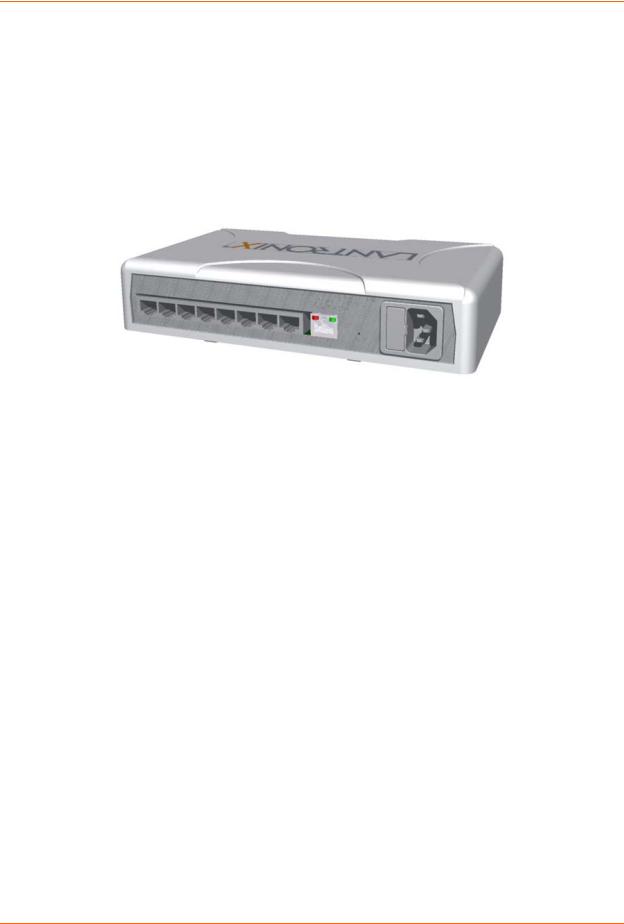
2: Introduction
EDS8PS and EDS16PS Overview
The EDS8PS (8 serial ports) and EDS16PS (16 serial ports) are compact desktop device servers that give you the ability to networ k-enable asynchronous RS-232 serial devices. They provide fully transparent RS-232 point-to-point connections without requiring modifications to existing software or hardware in your application.
Figure 2-1 EDS8PS Device Server
Features
Key features of the EDS8PS and EDS16PS include:
Dual-purpose Ethernet terminal server and device server design.
8 (EDS8PS) or 16 (EDS16PS) serial ports with hardware handshaking signals.
RS-232 support.
An RJ45 Ethernet port.
8 MB Flash memory.
32 MB random access memory (RAM).
Lantronix Evolution OS™.
A dedicated console port.
AES, SSH, or SSL secure data encryption.
Three convenient configuration methods (Web, command line, and XML).
Print server functionality (LPR/LPD).
See Chapter 3: Installation of EDS8PS and EDS16PS for installation instructions.
EDS User Guide |
17 |
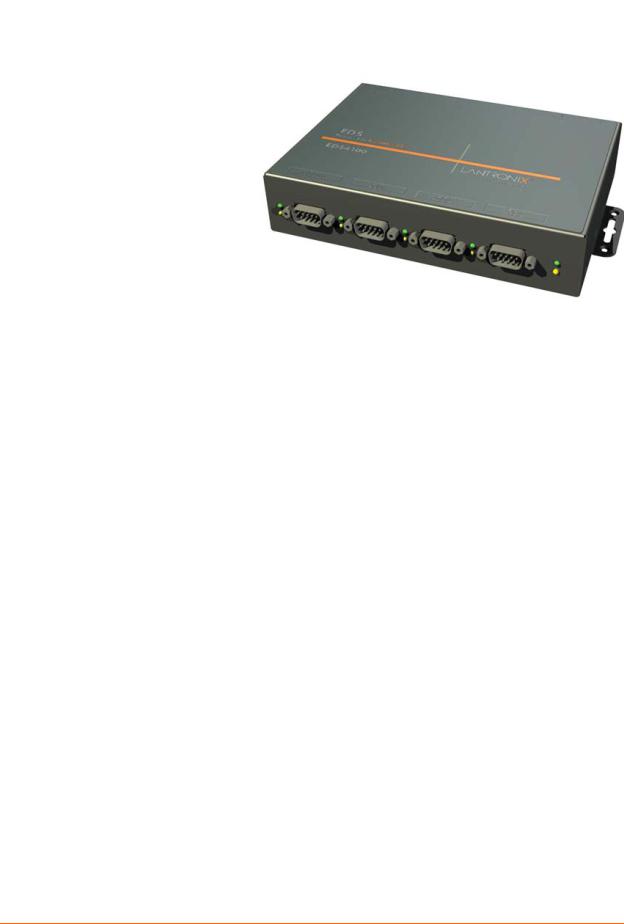
|
2: Introduction |
EDS4100 Overview |
|
The EDS4100 is a compact device |
Figure 2-2 EDS4100 4 Port Device Server |
server that allows you to network- |
|
enable asynchronous RS-232 and |
|
RS-422/485 serial devices. It can |
|
deliver fully transparent RS-232/ |
|
422 point-to-point connections and |
|
RS-485 multi-drop connections |
|
without requiring modifications to |
|
existing software or hardware in |
|
your application. |
|
Ports 1 through 4 support |
|
RS-232 devices. |
|
Ports 1 and 3 also support |
|
RS-422/485. |
|
Note: RS-485 circuits support 32 full-load devices or 128 quarter-load devices. Each RS-485 port, however, counts as one device, leaving up to 31 full-load or 127 quarter-load devices that can be connected to the RS-485 circuit.
The EDS4100 device server supports the Power-over-Ethernet (PoE) standard. With PoE, power is supplied to the EDS over the Ethernet cable, by either an Ethernet switch or a midspan device. Being able to draw power through the Ethernet cable eliminates power supply and cord clutter. It also allows the EDS to be located in areas where power is not typically available.
Features
The key features of the EDS4100 include:
Dual-purpose Ethernet terminal server and device server design.
Four serial ports with hardware handshaking signals.
RS-232 and RS-422/485.
One RJ45 Ethernet port.
IEEE 802.3af standard for Power-over-Ethernet (PoE).
8 MB Flash memory.
32 MB Random Access Memory (RAM).
Lantronix Evolution OS™.
AES, SSH, or SSL secure data encryption.
Three configuration methods (Web, command line, and XML).
Print server functionality (LPR/LPD).
See Chapter 4: Installation of EDS4100 for installation instructions.
EDS User Guide |
18 |
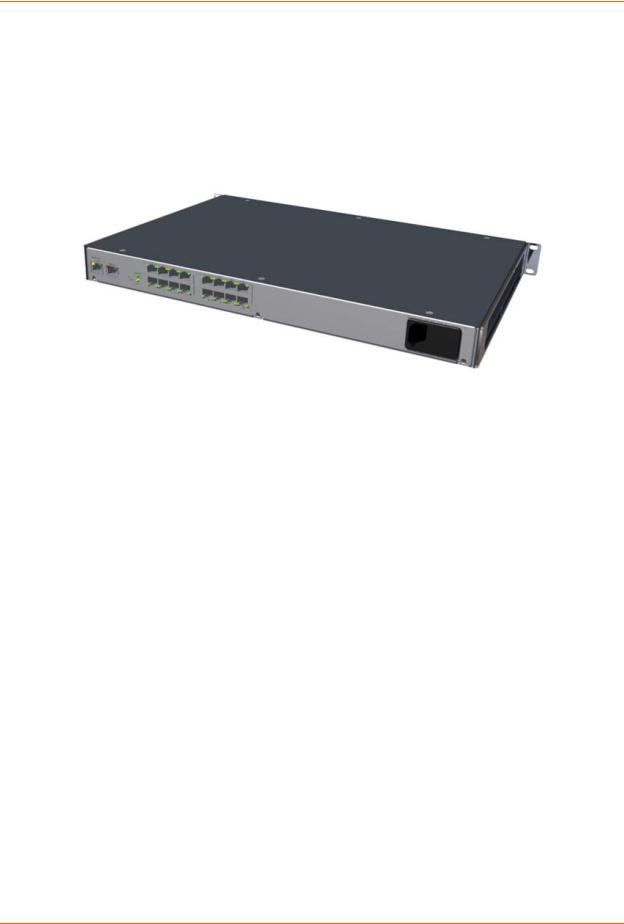
2: Introduction
EDS8PR, EDS16PR, and EDS32PR Overview
The EDS8PR (8 serial ports), EDS16PR (16 serial ports), and EDS32PR (32 serial ports) are compact easy-to-use, rack-mountable device servers that give you the ability to network-enable asynchronous RS-232 serial devices. They provide fully transparent RS-232 point-to-point connections without requiring modifications to existing software or hardware components in your application.
Figure 2-3 EDS16PR Device Server
Features
The key features of the EDS8PR, EDS16PR, and EDS32PR include:
Dual-purpose Ethernet terminal server and device server design.
8 (EDS8PR), 16 (EDS16PR) or 32 (EDS32PR) serial ports with hardware handshaking signals.
RS-232 support.
One RJ45 Ethernet port.
8 MB Flash memory.
32 MB Random Access Memory (RAM).
Lantronix Evolution OS™.
A dedicated console port.
AES, SSH, or SSL secure data encryption.
Three configuration methods (Web, command line, and XML).
Print server functionality (LPR/LPD).
See Chapter 5: Installation of EDS8PR, EDS16PR and EDS32PR, for installation instructions.
EDS User Guide |
19 |

2: Introduction
Applications
The EDS device server connects serial devices such as those listed below to Ethernet networks using the IP protocol family.
ATM machines
Data display devices
Security alarms and access control devices
Modems
Time/attendance clocks and terminals
Patient monitoring equipment
Medical instrumentation
Industrial Manufacturing/Automation systems
Building Automation equipment
Point of Sale Systems
Protocol Support
The EDS device server contains a full-featured TCP/IP stack. Supported protocols include:
ARP, IP, UDP, TCP, ICMP, BOOTP, DHCP, AutoIP, Telnet, DNS, FTP, TFTP, HTTP/HTTPS, SSH, SSL/TLS, SNMP, SMTP, RSS and Syslog for network communications and management.
TCP, UDP, TCP/AES, UDP/AES, Telnet, SSH and SSL/TLS for tunneling to the serial port.
TFTP, FTP, and HTTP for firmware upgrades and uploading files.
Evolution OS™
The EDS incorporates the Lantronix Evolution OS™. Key features of the Evolution OS™ include:
Built-in Web server for configuration and troubleshooting from Web-based browsers
CLI configurability
SNMP management
XML data transport and configurability
Really Simple Syndication (RSS) information feeds
Enterprise-grade security with SSL and SSH
Comprehensive troubleshooting tools
EDS User Guide |
20 |

2: Introduction
Additional Features
Modem Emulation
In modem emulation mode, the EDS can replace dial-up modems. The unit accepts modem AT commands on the serial port, and then establishes a network connection to the end device, leveraging network connections and bandwidth to eliminate dedicated modems and phone lines.
Web-Based Configuration and Troubleshooting
Built upon Internet-based standards, the EDS enables you to configure, manage, and troubleshoot through a browser-based interface accessible anytime from anywhere. All configuration and troubleshooting options are launched from a web in terface. You can access all functions via a Web browser, for remote access. As a result, you decrease downtime (using the troubleshooting tools) and implement configuration changes (using the configuration tools).
Command-Line Interface (CLI)
Making the edge-to-enterprise vision a reality, the EDS with the Evolution OS™ uses industrystandard tools for configuration, communication, and control. For example, the Evolution OS™ uses a Command Line Interface (CLI) whose syntax is very similar to that used by data center equipment such as routers and hubs.
VIP Access
Virtual IP Access is the Lantronix technology that solves the access-through-firewall problem. With VIP Access, the EDS can act as a ManageLinx DSC and provide direct access to your equipment behind a firewall.
SNMP Management
The EDS supports full SNMP management, making it ideal for applications where device management and monitoring are critical. These features allow networks with SNMP capabilities to correctly diagnose and monitor EDS.
XML-Based Architecture and Device Control
XML is a fundamental building block for the future growth of M2M networks. The EDS supports XML-based configuration setup records that make device configuration transparent to users and administrators. The XML is easily editable with a standard text or XML editor.
Really Simple Syndication (RSS)
The EDS supports Really Simple Syndication (RSS) for streaming and managing on-line content. RSS feeds all the configuration changes that occur on the device. An RSS aggregator then reads (polls) the feed. More powerful than simple email alerts, RSS uses XML as an underlying Web page transport and adds intelligence to the networked device, while not taxing already overloaded email systems.
Enterprise-Grade Security
Evolution OS™ provides the EDS the highest level of networking security possible. This ‘data center grade’ protection ensures that each device on the M2M network carries the same level of security as traditional IT networking equipment in the corporate data center.
EDS User Guide |
21 |

2: Introduction
By protecting the privacy of serial data transmitted across public networks, users can maintain their existing investment in serial technology, wh ile taking advantage of the highest data-protection levels possible.
SSH and SSL are able to do the following:
Verify the data received came from the proper source
Validate that the data transferred from the source over the network has not changed when it arrives at its destination (shared secret and hashing)
Encrypt data to protect it from prying eyes and nefarious individuals
Provide the ability to run popular M2M protocols over a secure SSH or SSL connection
In addition to keeping data safe and accessible, the EDS has robust defenses to hostile Internet attacks such as denial of service (DoS), which can be used to take down the network. Moreover, the EDS cannot be used to bring down other devices on the network.
You can use the EDS with the Lantronix Secure Com Port Redirector (SCPR) to encrypt COM port-based communications between PCs and virtually any electronic device. SCPR is a Windows application that creates a secure communications path over a network between the computer and serial-based devices that are traditionally controlled via a COM port. With SCPR installed at each computer, computers that were formerly “hard-wired” by serial cabling for security purposes or to accommodate applications that only understood serial data can instead communicate over an Ethernet network or the Internet.
Terminal Server/Device Management
Remote offices can have routers, PBXs, servers and other networking equipment that require remote management from the corporate facility. The EDS easily attaches to the serial ports on a server, Private Branch Exchange (PBX), or other networking equipment to deliver central, remote monitoring and management capability.
Troubleshooting Capabilities
The EDS offers a comprehensive diagnostic toolset that lets you troubleshoot problems quickly and easily. Available from the Web Manager, CLI, and XML interfaces, the diagnostic tools let you:
View critical hardware, memory, MIB-II, buffer pool, and IP socket information.
Perform ping and traceroute operations.
Conduct forward or backup DNS lookup operations.
View all processes currently running on the EDS, including CPU utilization and total stack space available.
Configuration Methods
After installation, the EDS requires configuration. For the unit to operate correctly on a network, it must have a unique IP address on the network. There are four basic methods for logging into the EDS and assigning IP addresses and other configurable settings:
DeviceInstaller: Configure the IP address and related settings and view current settings on the using a Graphical User Interface (GUI) on a PC attached to a network. See Using DeviceInstaller (on page 41).
EDS User Guide |
22 |

2: Introduction
Web Manager: Through a web browser, configure the EDS settings using the Lantronix Web Manager. See Configuration Using Web Manager (on page 43).
Command Mode: There are two methods for accessing Command Mode (CLI): making a Telnet connection or connecting a terminal (or a PC running a terminal emulation program) to the unit’s serial port. (See the EDS Command Reference Guide for instructions and available commands.)
XML: The EDS supports XML-based configuration and setup records that make device configuration transparent to users and administrators. XML is easily editable with a standard text or XML editor. (See the EDS Command Reference Guide for instructions and commands.)
Addresses and Port Numbers
Hardware Address
The hardware address is also referred to as the Ethernet address or MAC address. The first three bytes of the Ethernet address are fixed and read 00-20-4A, identifying the unit as a Lantronix product. The fourth, fifth, and sixth bytes are unique numbers assigned to each unit.
Figure 2-4 Sample Hardware Address
00-20-4A-14-01-18 or 00:20:4A:14:01:18
IP Address
Every device connected to an IP network must have a unique IP address. This address references the specific unit.
Port Numbers
Every TCP connection and every UDP datagram is defined by a destination and source IP address, and a destination and source port number. For example, a Telnet server commonly uses port number 23.
The following is a list of the default server port numbers running on the EDS:
TCP Port 22: SSH Server (Command Mode configuration)
TCP Port 23: Telnet Server (Command Mode configuration)
TCP Port 80: HTTP (Web Manager configuration)
TCP Port 443: HTTPS (Web Manager configuration)
UDP Port 161: SNMP
TCP Port 21: FTP
UDP Port 69: TFTP
UDP Port 514: Syslog
TCP Port 515: LPD
UDP Port 30718: LDP (Lantronix Discovery Protocol) port
TCP/UDP Port 10001: Tunnel 1
EDS User Guide |
23 |
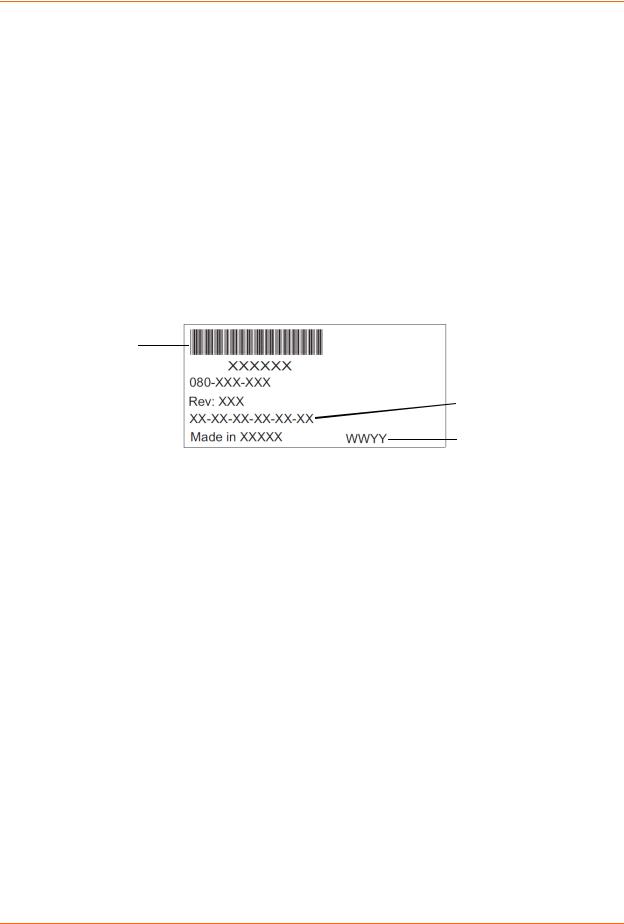
2: Introduction
Note: Multi-port products include one or more additional supported ports and tunnels with default sequential numbering. For instance: TCP/UDP Port 10002: Tunnel 2, TCP/ UDP Port 10003: Tunnel 3, etc.
Product Information Label
The product information label on the unit contains the following information about the specific unit:
Bar Code
Product Revision
Hardware Address (MAC Address or Serial Number)
Manufacturing Date Code
Figure 2-5 Product Label
Bar Code
Product Revision |
|
Hardware/MAC Address |
|
Manufacturing Date Code
EDS User Guide |
24 |

3:Installation of EDS8PS and EDS16PS
This chapter describes how to install the EDS8PS and EDS16PS device servers.
Package Contents
Your EDS package includes the following items:
One EDS device server (EDS8PS or EDS16PS)
One RJ45-to-DB9F serial cable
One power cord
User-Supplied Items
To complete your EDS8/16PS installation, you need the following items:
RS-232 serial devices that require network con nectivity. Each EDS8/16PS serial port supports a directly connected RS-232 serial device.
A serial cable for each serial device to be connected to the EDS8/16PS. All devices attached to the device ports support the RS-232C (EIA-232) standard. Category 5 cabling with RJ45 connections is used for the device port connections.
Note: To connect an EDS8/16PS serial port to a DTE device, you need a DTE cable, such as the one supplied in your EDS8/16PS package, or an RJ45 patch cable and DTE adapter. To connect the EDS8/16PS serial port to a DCE device, you need a DCE (modem) cable, or an RJ45 patch cable and DTE adapter. For a list of the Lantronix cables and adapters you can use with the EDS8/16PS, see the Appendix D - Lantronix Cables and Adapters (on page 158).
An available connection to your Ethernet network and an Ethernet cable.
A working power outlet.
EDS User Guide |
25 |
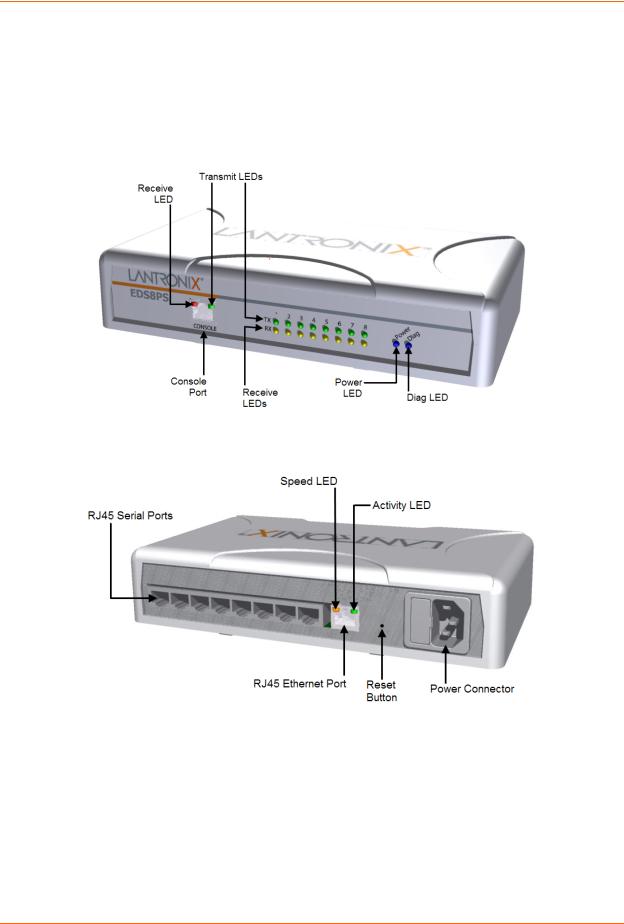
3: Installation of EDS8PS and EDS16PS
Identifying Hardware Components
Figure 3-1 shows the front of the EDS8PS. Figure 3-2 shows the back of the EDS8PS.
Figure 3-1 Front View of the EDS8PS
Figure 3-2 Back View of the EDS8PS
Serial Ports
The EDS8PS has 8 serial ports and the EDS16PS has 16 serial ports on the back panel. All are configured as DTE and support up to 230,400 baud.
Console Port
The front panel of the EDS8/16/32PR provides an RJ45 Console port, configured as DTE and supports baud rates up to 230,400 baud.
Note: The console port cannnot be used as a serial port.
EDS User Guide |
26 |

3: Installation of EDS8PS and EDS16PS
Figure 3-3 RJ45 Serial Port
Ethernet Port
The back panel of the EDS8/16PS provides a network interface via the right most RJ45 port. This port can connect to an Ethernet (10 Mbps) or Fast Ethernet (100 Mbps) network. The Speed LED on the back of the EDS8/16PS shows the connecti on of the attached Ethernet network. The EDS8/ 16PS can be configured to operate at a fixed Ethernet speed and duplex mode (halfor fullduplex). Otherwise by default, the EDS8/16PS auto-negotiates the connection to the Ethernet network.
LEDs
Light-emitting diodes (LEDs) on the front panel show status information.
Each serial port plus the console port have a Transmit and a Receive LED. The Ethernet port has Speed, Activity, Power, and Status LEDs.
The table below describes the LEDs on the front of the EDSPS.
|
Table 3-4 Front Panel LEDs |
|
|
LED |
Description |
Transmit (green) |
Blinking = EDS is transmitting data on the serial port. |
|
|
Receive (yellow) |
Blinking = EDS is receiving data on the serial port. |
|
|
Power (blue) |
On = EDS is receiving power. |
|
|
Diag (green) |
Fast blink = initial startup (loading OS). |
|
Slow blink (once per second) = operating system startup. |
|
On = unit has finished booting. |
Speed (yellow) |
On = EDS is connected to a 100 Mbps Fast Ethernet network. |
|
|
|
Off = EDS is connected to a 10 Mbps Ethernet network. |
|
|
Activity (green) |
Blink = EDS is sending data to or receiving data from the Ethernet network. |
|
|
Reset Button
The reset button is on the rear of the device to the right of the Ethernet port, accessible through a hole in the case. You can use it to reboot the unit or to reload factory defaults.
Reboot the device:
EDS User Guide |
27 |

3: Installation of EDS8PS and EDS16PS
1.Press and hold the reset button for about 3 seconds. The status LED blinks quickly.
2.When the fast blinks stop, release the button. When the unit reboots, the status LED changes from a fast blink to a solid ON.
Restore factory defaults:
1.Press and hold the reset button for about 11 seconds. The LED blinks quickly for about 3 seconds, then comes on for about 5 seconds, then blinks slowly for about 2 seconds.
2.When the slow blinks stop, release the button.
Installing the EDS8/16PS
Finding a Suitable Location
You can install the EDS8/16PS either in a shelf or as a desktop unit.
If using AC power, avoid outlets controlled by a wall switch.
Connecting the EDS8/16PS
All EDS serial ports support RS-232 devices.
Connect the EDS8/16PS to one or more serial devices.
1.Power off the serial devices.
2.Attach a CAT 5 serial cable between the EDS8/16PS and your serial device. See the
Appendix D - Lantronix Cables and Adapters (on page 158), for a list of cables and adapters you can use.
3.Connect an Ethernet cable between the EDS8/16PS Ethernet port and your Ethernet network.
4.Insert the power cord into the back of the EDS8/16PS. Plug the other end into an AC wall outlet.
5.Power up the serial devices.
EDS User Guide |
28 |
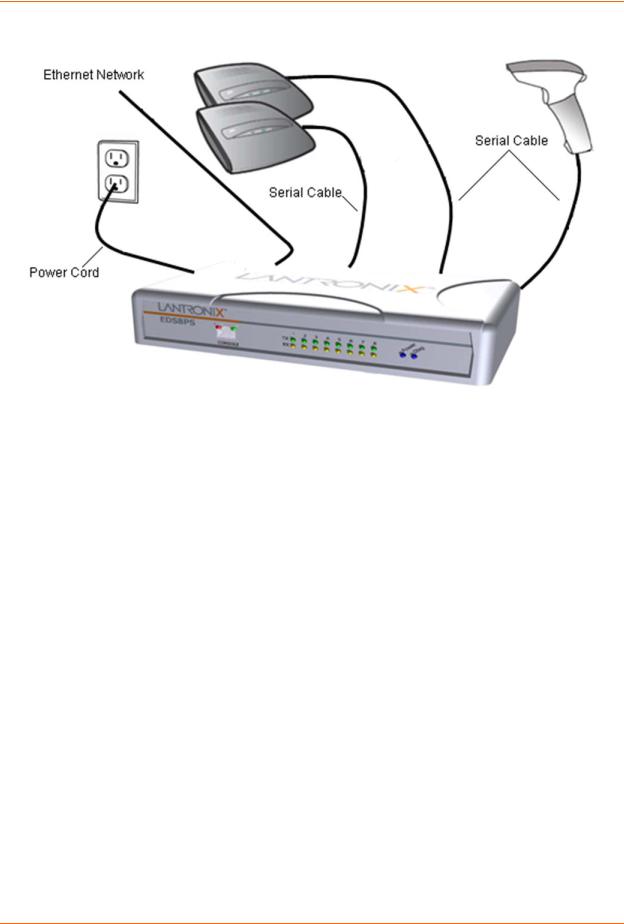
3: Installation of EDS8PS and EDS16PS
Figure 3-5 Example of EDS8/16PS Connections
EDS User Guide |
29 |

4:Installation of EDS4100
This chapter describes how to install the EDS4100 device server.
Package Contents
Your EDS4100 package includes the following items:
One EDS4100 device server.
One DB9F-to-DB9F null modem cable.
A printed Quick Start Guide.
Your package may also include a power supply.
User-Supplied Items
To complete your EDS4100 installation, you need the following items:
RS-232 and/or RS-422/485 serial devices that require network connectivity:
A serial cable for each serial device. One end of the cable must have a female DB9 connector for the EDS4100 serial port.
To connect an EDS4100 serial port to another DTE device, you will need a null modem cable, such as the one supplied in your EDS4100 package.
To connect the EDS4100 serial port to a DCE device, you will need a straight-through (modem) cable.
An available connection to your Ethernet network and an Ethernet cable.
A working power outlet if the unit will be powered from an AC outlet.
Identifying Hardware Components
The following two figures show the front and back of the EDS4100.
EDS User Guide |
30 |
